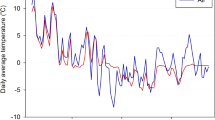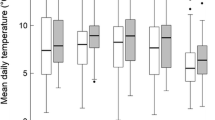Abstract
The effects of photoperiod and light intensity on flowering in Mat Rush cv. Gangshan 3 were studied. The results showed that treatments with longer day length stimulated flowering significantly and increased stem flowering percentage (SFP). Plants treated with low light intensity at early stage had substantially reduced florets per cyme, SFP, tillers per plant and stem length. At middle and late stage, low light intensity significantly reduced SFP. The principal climatic factors affecting SFP were as follows: mean temperatures (MT) of the third ten-day period (TDP) in December and of the second TDP in February, actual sunlight hours (SH) of the third TDP in February and precipitation of the third TDP in March. A nonlinear simulation model for SFP was established with experimental results and corresponding climatic data (see Eq. (2)).
Simulation by the above equation yielded values the same as those observed from 1992 to 2000, indicating its accuracy in describing the relationship between flowering and light and temperature conditions. The interaction between vernalization and SH is also discussed in this paper.
Similar content being viewed by others
References
Ahmad, M., Jarillo, J. A., Smirnova, O., Cashmore, A. R., 1998. The CRY1 blue light photoreceptor of Arabidopsis interacts with phytochrome A in vitro.Molecule Cell.,1:939–948.
Araki, T., 2001. Transition from vegetative to reproductive phase.Curr Opin Plant Biol.,4(1):63–68.
Battey, N. H., Lyndon, R. F., 1990. Reversion of flowering.Botany Review.,56(2):162–165.
Battey, N. H., 2000. Aspects of seasonality.J Exp Bot.,51(352):1769–80.
Bouman, B. A. M., Vankeulen, H., 1996. The school of de Wit' crop growth simulation models: A pedigree and historical overview.Agriculture System,52(2–3):171–198.
Chen, Y. N., Li, W. A., 1993. De novo flower differentiation in tissue culture of marigold, violet orychophragmus and tobacco.China Science Bulletin,38(3):235–237.
Frankhauser, C., Chory, J., 1999. Light receptor kinases in plants.Current Biology,9:R123–126.
Fu, Y. F., Meng, F. J., 1997. Floral determination of plants.Plant physiology Communications,33(2):81–87.
Kinet, J. M., 1977. Effect of light condition on the development of the inflorescence in tomato.Scientia Horticulturae,6:15–26.
Lang, A., 1965. Encyclopedia of Plant Physiology. Ruhland, W. Berlin (ed.), Springer, p. 1489–1536.
Levy, Y. Y., Dean, C., 1998. The transition to flowering.Plant Cell, (10):1973–1989.
Lin, Chengtao, 2000. Photoreceptors and regulation of flowering time.Plant physiology,123:39–50.
Lyndon, R. F., 1998. Reversion of flowering.In: R. F. Lyndon ed., The Shoot Apical Meristem: Its Crowth and Development, Cambridge University Press, Cambridge, UK. p. 221–222.
McDaniel, C. N., Singer, S. R., and Smith, S. M. E., 1992. Developmental states associated with the floral transition.Dev. Biol.,153:59–69.
McMaster, G. S., Wilheim, W. W., Morgan, J. A., 1992. Simulating winter wheat shoot apex phenology.Journal of Agricultural Science,119:1–12.
Ruo, W. X., Yu, G. H., Li, F. L., 1991. Some photosynthetic characteristics of American Ginseng under different light intensity.Plant physiology Communications,1:35–37.
Shen, W. Q., Zhang, G. P., Gui, W. G., 2002. Effect of light on the growth and stem flowering rate of Mat Rush.Chinese Journal of Applied Ecology,13(5):577–580 (in Chinese).
Tookea, F., Battey, N. H., 2000, A Leaf-derived signal Is a quantitative determinant of floral form in impatients.Plant Cell,12:1837–1848.
Vince-Prue, D., 1975. Vernalization.In: Photoperiodism in Plants, London, McGraw Hill, p. 263–291.
Wang, Z. F., Chen, J. X., 1987. The Effect of light intensity on plant development and yield of rape.Journal of Human College,35(Supplement):29–35 (in Chinese).
Yin, X. Y., Qi, C. H., Xie, H. A., 1989. A model bank on the technical decision of crop production,In: Pro. of International Conference on Systems Science and Engineering, Beijing, p. 887–891.
Yin, X. Y., Qi, C. H., 1994. Studies on the rice growth calendar simulation model (RICAM) and its application.Acta Agronomica Sinica,20(3):339–346.
Yu, S. M., 1982. Study on morphological and biological character of common rush.Acta Agriculture Universitatis Zhejianensis,8(2):131–142 (in Chinese).
Author information
Authors and Affiliations
Corresponding author
Additional information
Project (No. 981105) supported by the Ningbo City Science Foundation, China
Rights and permissions
About this article
Cite this article
Wei-qi, S., Guo-ping, Z., Li-feng, X. et al. Effects of light and temperature conditions on flowering in Mat Rush. J. Zhejiang Univ. Sci. A 3, 611–616 (2002). https://doi.org/10.1631/jzus.2002.0611
Received:
Accepted:
Published:
Issue Date:
DOI: https://doi.org/10.1631/jzus.2002.0611
Key words
- Mat Rush (Juncus effuses L. Var. Decipiens Bchen)
- Light
- Temperature
- Stem flowering rate
- Simulation model




